Energy Transition: What is an Offshore Vessel Operator to Do?
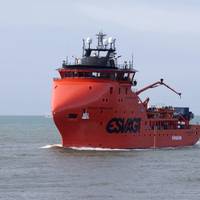
The energy transition is moving ahead amid recovery in offshore oil & gas and growth in offshore wind, leaving vessel owners that serve these markets with big questions about energy carrier and energy converter selection for their newbuilds.What is driving the change?The foundations of energy transition in the offshore and marine segment can be found at global, regional, national and local levels:At a global level, International Maritime Organization (IMO) measures cover vessel energy efficiency (for vessels over 400 gross tonnes) and carbon intensity (for vessels over 5…
Digitalization: Simulating Cleaner Shipping

Technologies developed and deployed in pursuit of net zero bring environmental and societal benefits for shipping owners and operators to outweigh their own emissions.SIM is a technology with the potential to make a significant contribution to maritime decarbonization, writes Patrick Ryan, ABSOne of the biggest problems for shipowners seeking to understand how environmental regulation will impact the performance of their fleets in future is uncertainty. While the regulatory framework is in place…
New Device Aims to Improve Docking Safety

A new innovative device has been engineered to improve docking safety.Designed to be installed on quay walls, the Dynamic Protective Barrier features a novel mechanism to dissipate energy for short duration impact caused by docking vessels.Matthew Czerniatewicz, founder of Dynamic Protective Barriers (DPB), said other solutions available on the market today typically absorb and accumulate the kinetic energy at the point of docking, which can cause micro and macro damages to the port infrastructure and as well as the ship.
Tech File: Dynamic Protective Barrier
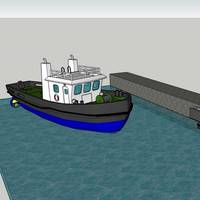
Dynamic Protective Barrier (DPB) is an innovative safety device with a novel mechanism proposed to dissipate energy for short duration impact caused by the docking ship and/or vessels.The main job of the device is to dampen and contain the vessel movements, thus eliminating the effect that passing ships, tides, wind and long-period waves have on moored vessels and the constant low velocity impact that occurs with the port infrastructure. This means using Dynamic Protective Barrier…
Multraship, Novatug Name 2 CRTs
Netherlands-based towage and salvage provider, Multraship, has held the christening ceremony for two new Novatug Carrousel Rave tug (CRTs) at Rotterdam.Multratug 32 was christened by Mrs Muller-Ribbens and Multratug 33 by The Netherlands Minister of Infrastructure and Water Management, the Honourable Coravan Nieuwenhuizen.The CRTs offer radical improvements in safety and operational efficiency and will help with the optimization of port usage. The CRTs are able to work with seagoing vessels at much higher speeds than conventional tugs without the risk of capsizing under a tow-load.The sister vessels were delivered in 2018 by Netherlands shipyard Damen Maaskant.
ABS, MARIN Launch Wind Propulsion Project
The classification society ABS and Netherlands based research institute MARIN have launched a Joint Industry Project (JIP) to investigate transparent and validated methods to assess performance of wind-assisted shipping propulsion technologies.The wind propulsion technology is a key driver in owners/operators investment decision-making.The JIP focuses on the majority of all marketed wind-assisted ship propulsors, while also aims to overcome the challenge to the uptake of these technologies by:- Improving methods for transparent performance prediction.- Using the improved methods to provide ship owners/operators with fast predictions…
Cress Systems Helps Container Terminals
Cress Systems helps container terminals reduce fuel bills, emissions and power peaks with ProwESS energy storage for rubber-tyred gantry cranes (RTGs). New technology allows container ports and terminals to capture, store and reuse energy from container yard handling equipment to reduce fuel cost and emissions and better manage peak electricity demands. Following a successful proof of concept trial at the UK Port of Felixstowe, Cress Systems is pleased to announce the commercial release of its ProwESS energy capture, storage and reuse system for container terminal yard handling equipment. The first version of the system has been designed for rubber-tyred gantry cranes (RTGs), the global workhorse of yard operations, with a second version under development for straddle carriers.
US Navy: 355-Ship Fleet is the Mandate, Funding It is Fuzzy
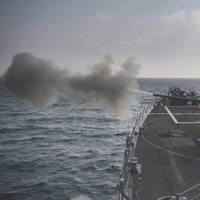
As Congress wrestles with the budget, there is at least a bipartisan consensus that defense spending should grow, and that includes growing the Navy’s fleet. The current goal is 355 ships, an admirable goal, but an objective that faces many cost hurdles. The surface fleet (which excludes submarines and aircraft carriers) needs to grow in capability and capacity. The numbers of ships being procured or envisions would increase as the total n umber of ships increases, but the number in this story represents current program status.
First of Two New Tugs Delivered to Multraship

Towage and salvage specialist Multraship has taken delivery of the first of two new Carrousel Rave Tugs (CRT). The vessel, which was commissioned as Multratug 32 and delivered by Netherlands shipyard Damen Maaskant in Stellendam, will operate under lease to Multraship. The contract for the vessels was agreed between Novatug, an arm of the group to which Multraship also belongs, and Damen’s specialist propulsion subsidiary Van der Velden Barkemeyer GmbH in November 2015. German shipyard Theodor Buschmann GmbH in Hamburg assembled the hulls, which were then moved to Stellendam for outfitting.
Inside the USS Gerald R. Ford
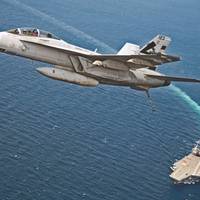
President Donald Trump addressed the more than 10,000 people attending the ceremony where the Navy’s newest aircraft carrier, USS Gerald R. Ford (CVN 78), was commissioned on Saturday, July 22 in Norfolk, Va. “Wherever this vessel cuts through the horizon, our allies will rest easy and our enemies will shake with fear because everyone will know that America is coming and America is coming strong,” said Trump. Acting Secretary of the Navy Sean Stackley recalled President Theodore Roosevelt, who used to say, “Walk softly, and carry a big stick.” Stackley then turned to Trump and said, “Mr.
US Navy to Display Electromagnetic Railgun
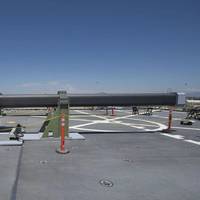
The U.S. The Electromagnetic Railgun – a weapon that the U.S. Navy says will play a significant role in its future – will be on display to the public for the first time on the East Coast Feb. 4-5 at the Naval Future Force Science and Technology (S&T) EXPO in Washington, D.C., officials at the Office of Naval Research (ONR) announced. With Chief of Naval Operations (CNO) Adm. Jonathan Greenert set as the event's keynote speaker on Feb. 4, the EXPO promises to be a window into the future of the U.S. Navy, showcasing the latest advances in power projection and force protection.
USN Railgun at Future Force EXPO
The Electromagnetic Railgun-a weapon that will play a significant role in the future of the U.S. Navy-will be on display to the public for the first time on the East Coast Feb. 4-5 at the Naval Future Force Science and Technology (S&T) EXPO in Washington, D.C., officials at the Office of Naval Research (ONR) announced Jan. 13. With Chief of Naval Operations (CNO) Adm. Jonathan Greenert set as the event's keynote speaker on Feb. 4, the EXPO promises to be a window into the future of the U.S. Navy, showcasing the latest advances in power projection and force protection. "This year's Expo will showcase the naval portfolio of innovative breakthrough technologies that are shaping our warfighting tactics today and changing the way our Sailors and Marines will operate in the future…
Quantitative Risk Analysis for LNG Terminals

Widescale Development of LNG Bunkering is Expected. Lloyd’s Register recently conducted a survey that indicated that the majority of major ports around the world are either planning for, or are anticipating, the widescale development of LNG bunkering. One of the locations is the Port of Rotterdam, which is a busy port with dense traffic on the various waterways consisting of both maritime and inland vessels. During the analysis, the probability of ship collisions was assessed and then the consequences were identified.
The Switch to Deliver Full-Power Converter for Floating Power Plant
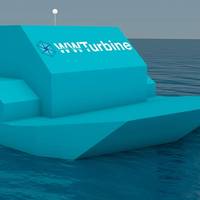
Vancouver-based Water Wall Turbine Inc. (WWT) has selected The Switch to provide a 500 kW full-power converter for its self-floating power plant. This new system extracts potential and kinetic energy from large, fast moving water currents for conversion into electric energy. The Switch will supply its first 500 kW full-power converter in October 2014 for WWT’s prototype project, which will be used for the Dent Island Resort, near Vancouver Island off the west coast of British Columbia, Canada. System testing of the integrated equipment is planned for the first quarter of 2015.
Classification Society BV Sharpens Ice Tools
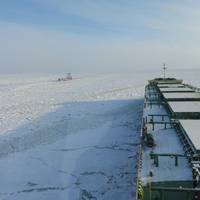
Bureau Veritas has responded to demand for safe LNG transportation in the Arctic regions by developing new high-level tools to assess cargo sloshing in ice conditions. It has also developed a cutting-edge probabilistic method for assessing ice loads on structure which will reduce the time and data needed to assess the structure of vessels and units designed for heavy ice operation. Pierre Besse, Director of Innovation, Bureau Veritas, says, “All eyes are on the Arctic sea routes and on the opening up of the Arctic mineral and energy resources.
Bureau Veritas Sharpens Ice Tools
International classification society Bureau Veritas has responded to demand for safe LNG transportation in the Arctic regions by developing new high-level tools to assess cargo sloshing in ice conditions. It has also developed a cutting-edge probabilistic method for assessing ice loads on structure which will reduce the time and data needed to assess the structure of vessels and units designed for heavy ice operation. Pierre Besse, Director of Innovation, Bureau Veritas, said, “All eyes are on the Arctic sea routes and on the opening up of the Arctic mineral and energy resources. We have to ensure the vessels and offshore units that operate in those extreme conditions are safe.
Berthing a Submarine
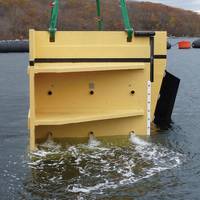
Berthing a fast attack or fleet ballistic missile (Trident) submarine requires skilled vessel handling, knowledge and practice. The larger Trident subs are 560 ft. long with a beam of 42 ft. and displace almost 17,000 tons. When maneuvering them into port a deep draft camel is a crucial aide to optimizing berthing and mooring procedures. The camel creates and maintains separation between a sub and a waterfront facility. Deflecting or compressing with vessel movement, the camel prevents damage to the hull…
Seahunter: Amazing Boat Torture Test
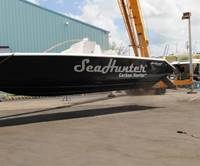
On September 20, 2011, SeaHunter Boats, a South Florida yacht builder, hoisted a new, standard production, 35 foot boat, twenty feet into the air and dropped it on a concrete yard at Plantation Boat Mart in Islamorada, Florida. The impact registered 100 g’s at the transom. The result was a thunderous sonic boom when the quarter million dollar vessel first hit the pavement. The kinetic energy, caused by the nearly four ton vessel falling towards earth, caused it to bounce off the hard pavement not once, but three times after the initial impact.
Market Report on High Altitude Wind Energy
The world’s demand for safe and clean energy continues to grow, with renewable sources playing an every greater role. Wind power generation, having expanding offshore, is now not only looking out but up. International renewable energy consultancy, GL Garrad Hassan, has issued the first market report which analyses the burgeoning new industry of High Altitude Wind Energy (HAWE). HAWE systems are designed to tap into the high velocity, stable air currents that exist at altitudes anywhere from 200m to 20 km above the earth; a source for generating cheaper and more abundant electricity than current wind technology. The report looks at the potential of high altitude winds as an energy source, the current technologies within the sector and their potential as mature systems.
First Self-Sufficient Zero Carbon Life Support Vessel (LSV)
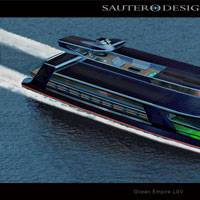
The Ocean Empire LSV (life support vessel) is a 144.3-ftSolar Hybrid Superyacht with two Hydroponic farms and fishing facilities to harvest the sea. Her solar powered propulsion systems and all the hotel amenities of a luxury global voyager are supplied by harnessing 3 major sources of sustainable of energy. The first and foremost source of energy is from the Sun which powers Solar Cells (covering the entire surface of the vessel) while at the same time illuminating 2 Hydroponic farms.
Maxview Smart Landing System Installation
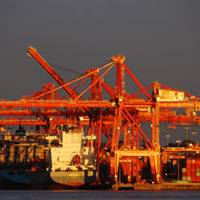
In the fourth quarter of 2008, TMEIC GE’s Maxview Smart Landing system entered service on a new ship-to-shore crane at Vancouver’s Centerm container terminal, operated by DP World (Canada) Inc. Operational data from the first 15 months proves that the semi-automatic system has met the company’s performance goals for preventing high-speed landings, which translates into reduced down-time and dollars saved. Performance results show that on average, when the Maxview Smart Landing system was in use…
Northrop Grumman Q4 2009 Results
Northrop Grumman Corporation (NYSE: NOC) reported Q4 2009 net earnings of $413 million, or $1.31 per diluted share, and 2009 net earnings of $1.7 billion, or $5.21 per diluted share. In 2008, the company reported a fourth quarter net loss of $2.5 billion, or $7.75 per diluted share, and a net loss for the year of $1.3 billion, or $3.77 per diluted share. 2008 fourth quarter and full year results were significantly impacted by a goodwill impairment charge. In December 2009, the company completed the sale of TASC, Inc. (TASC), its advisory services business, for $1.65 billion in cash and a net gain of $0.05 per share. TASC's operating results are accounted for as discontinued operations, and results for all periods presented in this release have been adjusted for the divestiture.
Northrop Grumman Q3 2009 Results
Northrop Grumman Corporation (NYSE: NOC) reported that third quarter 2009 earnings from continuing operations totaled $487 million, or $1.52 per diluted share, compared with $509 million, or $1.50 per diluted share, in the third quarter of 2008. Third quarter 2009 net pension adjustment (FAS/CAS) reduced earnings from continuing operations by $47 million, or $0.15 per diluted share, compared with an increase to earnings from continuing operations of $42 million, or $0.13 per diluted share, in the third quarter of 2008. Third quarter 2009 earnings included a net tax benefit of $75 million, or $0.23 per share, primarily for final settlement of the Internal Revenue Service's (IRS) examination of the company's 2001, 2002 and 2003 tax returns.





